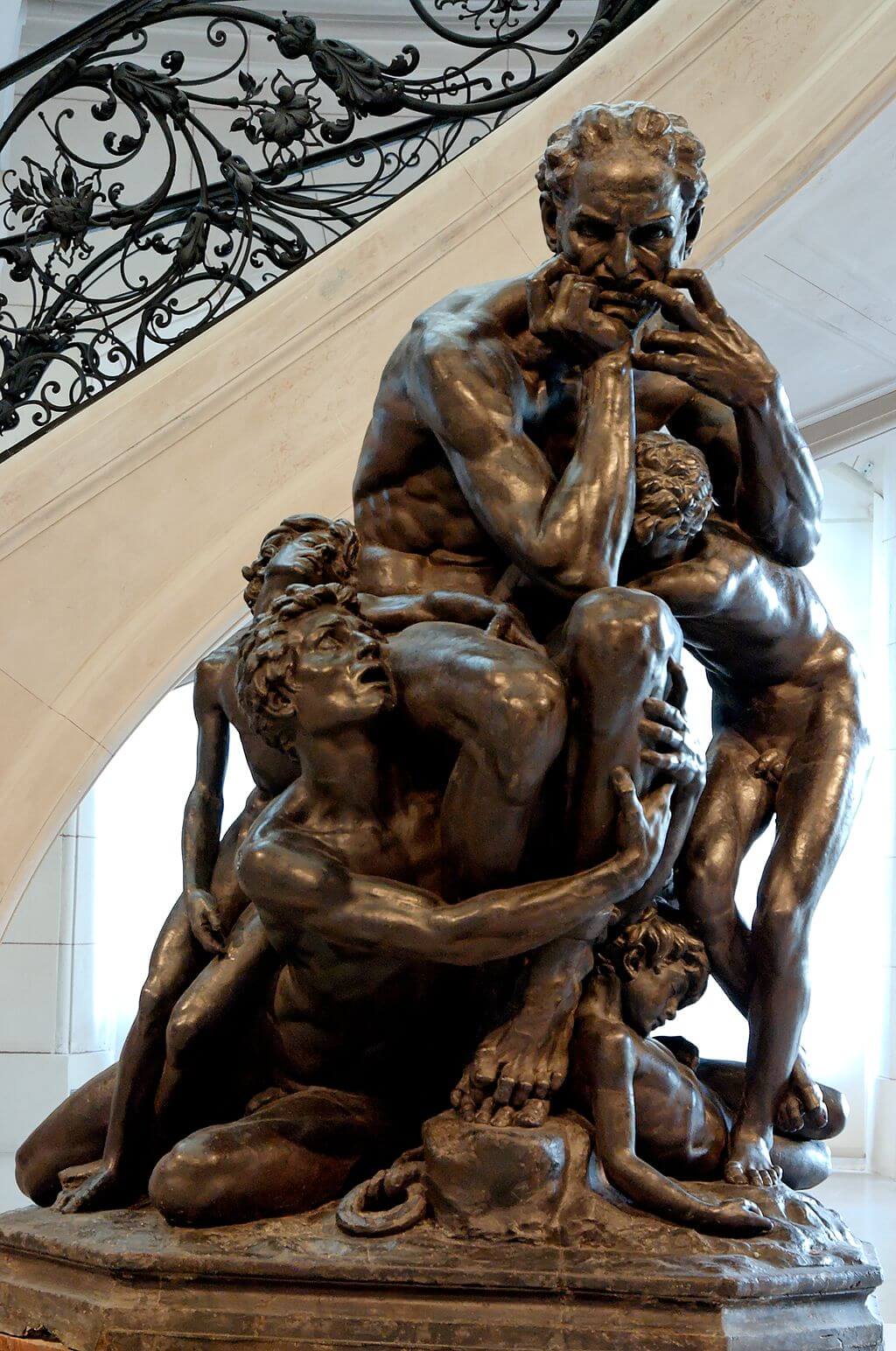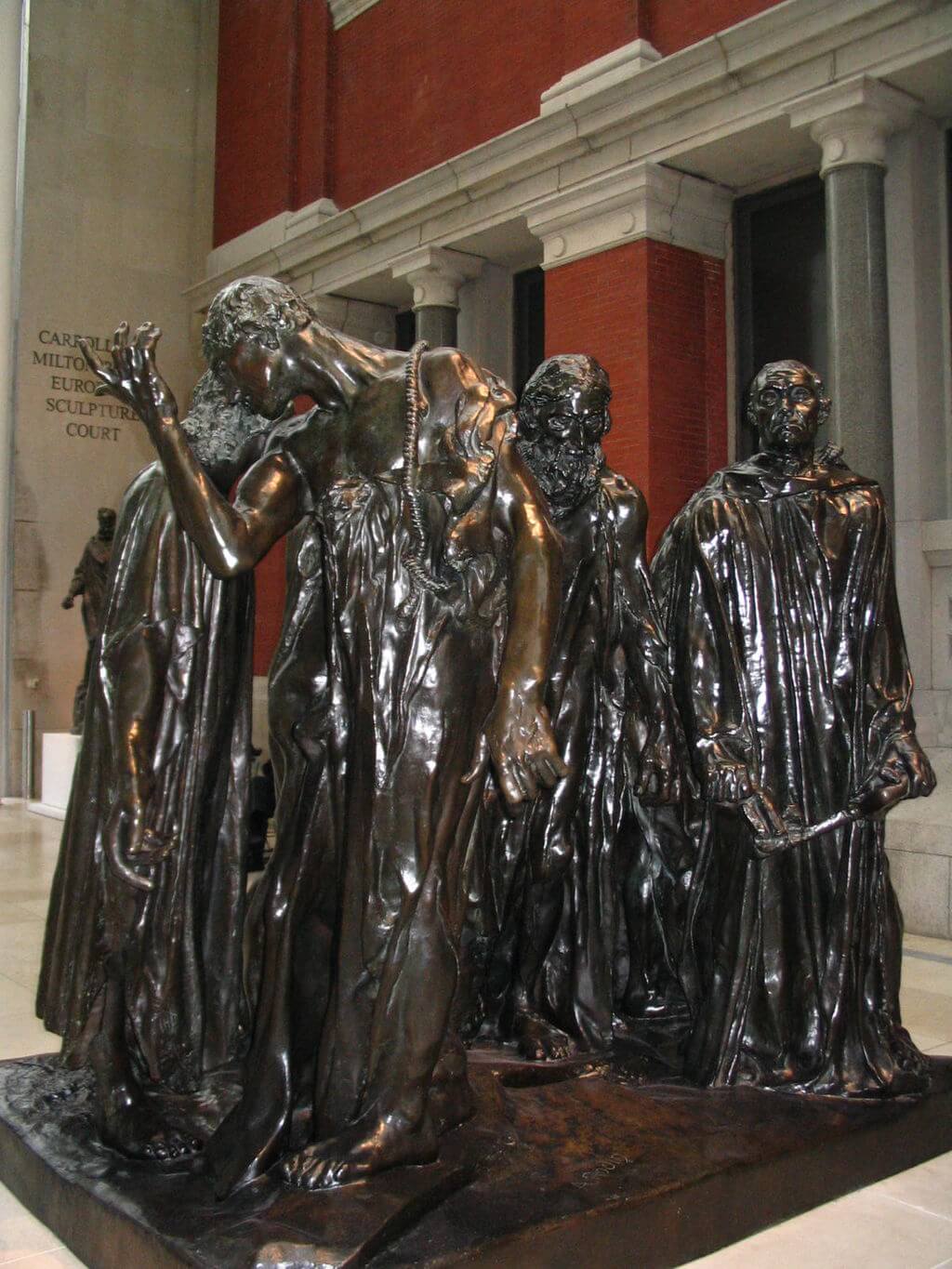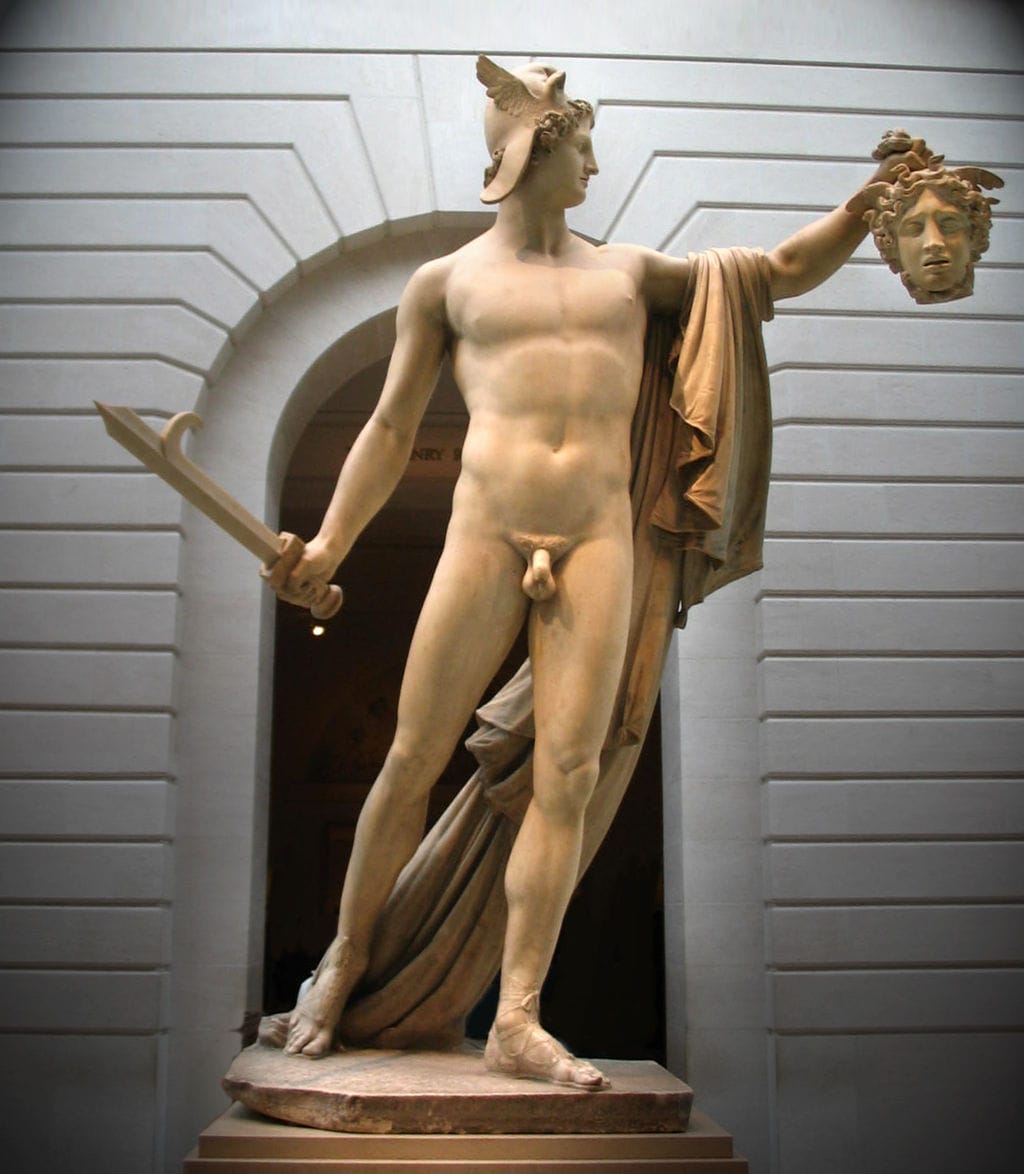|
Where?
What do you see? Ugolino is sentenced to starve to death together with his children. This sculpture shows the moment that Ugolino considers cannibalism. He is depicted together with his four children, all naked, but is ignoring his children in this sculpture. He looks desperately in the distance and is biting his fingers and pulls his lip down with them. He holds his head in the palm of his hand. He is contemplating the consequences of his sins. He is sculpted as a muscular man even though he is starving to death. He is bending forward and has his feet on top of each other. The four children are in different states of suffering, and they beg their father to eat them such that he can stay alive. The oldest boy seems most energetic. He has his fingers in the flesh of Ugolino’s leg to emphasize his begging. The second oldest son on the right is also holding his father with both hands. The second youngest son on the left sits on top of his oldest brother and has already lost most of his remaining energy. He has his left arm on his father’s leg. The youngest son is on the bottom right and while he is the only one with a peaceful expression he appears already dead. Carpeaux is telling a story with this sculpture, something that is very difficult to do in a sculpture. He was able to sculpt the skin, muscles, and veins very realistically and to express the strong emotions of the different subjects. The more you look at the details of this marble statue, the more "alive" the subjects become. For example, you can see Ugolino’s agony by the curve in his spine, and even the toes of Ugolino are curled to show his agony. Different versions of this statue: Several sculptures of Ugolino and His Sons have been made. Carpeaux got the idea of creating a sculpture of Ugolino and his sons in 1858. He started by making a plaster version of it, which he completed in 1861. This version is in the Petit Palais in Paris. After that, in 1862, he created a bronze version which is now in the Musée d’Orsay. The final version he created was the marble version in the Metropolitan Museum of Art. Rodin was inspired by the sculptures of Carpeaux and, in 1881, he made a plaster version of Ugolino and His Children which is in the Musée Rodin in Paris.
Backstory: This work is created under the supervision of Carpeaux and is based on canto 33 of Dante’s Inferno (which is the first part of the Divine Comedy). In this book, Dante travels through the nine circles of hell. Each circle contains people who are convicted in hell for a different sin. In the ninth circle, he meets Count Ugolino della Gherardesca (c. 1220-1289), who was convicted for treachery. In 1288, Ugolino worked together with the archbishop Ruggieri to take control of the factions in Pisa. However, in this process, Ruggieri betrayed him and locked Ugolino up in prison.
More precisely, Ugolino was imprisoned together with his children and grandchildren in a tower and condemned to starve to death. His children begged Ugolino to eat them to survive, and his hunger was stronger than his sadness about his dying children. It is unclear whether Ugolino ate his children in the end. In Dante’s story, Ugolino’s eternal punishment in hell is that he is stuck up to his head in the icy waste of Antenora which is the punishment for political traitors. Meanwhile, he is chewing the head of Ruggieri (the person who betrayed him in real life) who is also stuck in the ice. Who is Carpeaux? Jean-Baptiste Carpeaux (1827-1875) was born in Valenciennes, France and died in Paris. In 1854, he moved to Rome, where he got inspired by the Renaissance artists such as Donatello, Michelangelo, and Del Verrocchio. Carpeaux suffered a lot during his life, both mentally and physically, and you can see that back in some of his extreme works. His sculptures are known for the emotions they evoked among the viewers, and he distinguished himself with his style from his contemporary colleagues. He is considered one of the greatest sculptors of his time, though most people consider Antonio Canova (who was born before him) and Auguste Rodin (who was born after him) to be even better. Fun fact: The sculpture in the Metropolitan Museum of Art is placed very close to the entrance of the Petrie Court Café. It is ironic that this sculpture with the theme of starvation is so close to the Café. While this may be a coincidence in itself, another statue that deals with starvation is also close to the Café. Rodin’s bronze The Burghers of Calais sculpture shows six leaders of the city of Calais who are starving and have a rope around their neck as they will be executed soon. The marble statue of Carpeaux is also next to the statue of Perseus with the Head of Medusa by Antonio Canova.
Written by Eelco Kappe
References:
8 Comments
3/15/2019 06:03:45 am
Informative and interesting Blog! Beautifully written, as usual, I like the post. Thank you so much for nice sharing with us. Keep posting!
Reply
TripImprover
3/18/2019 09:57:47 am
Thank you for your feedback. I enjoyed scrolling through your website as well! There are some very beautiful items there.
Reply
7/5/2019 08:11:16 am
I really need this kind of information and must share with my circle. Thanks for sharing with us.
Reply
1/13/2022 03:04:16 am
Your post is very helpful right now. Thank you for sharing this informative one.
Reply
Jo Ann Currie
2/17/2022 02:03:59 pm
I am reading “My Name is Lucy Barton” by Elizabeth Strout and in Chapter 28 she refers to this sculpture. I googled a description (she doesn’t name the piece) and found your post. While I’ve been to the Met many times, I have never stopped to study this piece. Thank you for your details and backstory. Your words and images enriched the reading greatly. Next time we are in NYC (or Paris) we will make a point to spend time with the sculpture.
Reply
TripImprover
2/19/2022 01:08:56 am
Very interesting, it's a captivating sculpture indeed. Hope you can see it in person some time.
Reply
Thank you for this post and exploration. I, too, arrived here after googling the sculpture while reading My Name is Lucy Barton. The Met was my hometown museum and I didn't remember seeing this piece there, though I had seen versions of it at Orsay and The Rodin in Paris. I had been very moved by its supreme beauty and ugliness, the agony depicted. I had thought Ugolino had already resorted to eating one of his children. Thank you for edifying with Dante's story, which I had misremembered.
Reply
Leave a Reply. |
Categories
All
|
- Home
- Blog
-
Museums
- Alte Pinakothek
- Art Institute of Chicago
- Baltimore Museum of Art
- Barber Institute of Fine Arts
- Bargello
- Barnes Foundation
- British Museum
- Church of Sant’Anastasia
- Cleveland Museum of Art
- Courtauld Institute of Art
- Detroit Institute of Arts
- Frans Hals Museum
- Galleria Borghese
- Gallerie dell'Accademia
- Getty Museum
- Guggenheim
- Hermitage Museum
- Kunsthistorisches Museum
- Kunstmuseum Basel
- Legion of Honor Museum
- Louvre
- Mauritshuis
- Metropolitan Museum of Art
- Musee d’Orsay
- Museum of Fine Arts in Boston
- Museum of Modern Art
- National Gallery in London
- National Gallery of Art
- National Museum in Poznań
- Norton Simon Museum
- Ny Carlsberg Glyptotek
- Palace of Versailles
- Palazzo Pitti
- Palazzo Vecchio
- Petit Palais
- Philadelphia Museum of Art
- Prado
- Pushkin Museum
- Ravenna Art Museum
- Rijksmuseum
- San Diego Museum of Art
- Santa Maria delle Grazie
- St. Peter's Basilica
- Städel Museum
- Statens Museum for Kunst
- Tate Britain
- Tate Modern
- Timken Museum of Art
- Uffizi
- Vatican Museums
- Wallace Collection
-
Artists
- Altdorfer
- Anguissola
- Berlin Painter
- Bosch
- Botticelli
- Boucher
- Bronzino
- Bruegel the Elder
- Brunelleschi
- Cabanel
- Caillebotte
- Canova
- Caravaggio
- Carpeaux
- Cezanne
- Cimabue
- David
- Degas
- Delacroix
- De Maria
- Donatello
- El Greco
- Fontana
- Fra Angelico
- Fragonard
- Gauguin
- Gentileschi
- Gericault
- Gonzalez-Torres
- Goya
- Hals
- Hogarth
- Hokusai
- Ingres
- Leonardo da Vinci
- Lippi, Filippo
- Longhi, Barbara
- Lorrain
- Makovsky
- Manet
- Massys
- Matisse
- Merian
- Michelangelo
- Mochi
- Modigliani
- Monet
- Panini
- Parmigianino
- Perugino
- Picasso
- Pisanello
- Raphael
- Rembrandt
- Renoir
- Reynolds
- Rivera
- Rodin
- Rubens
- Scultori
- Seurat
- Steen
- Tintoretto
- Titian
- Toulouse-Lautrec
- Turner
- Uccello
- Van der Weyden
- Van Dyck
- Van Eyck
- Van Gogh
- Van Hemessen
- Vasari
- Velazquez
- Vermeer
- Veronese
- Vigée Le Brun
-
Locations
- Books
- About Us





